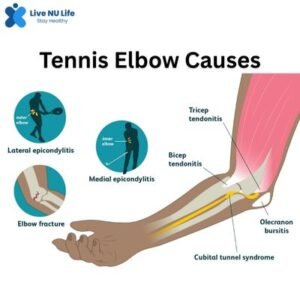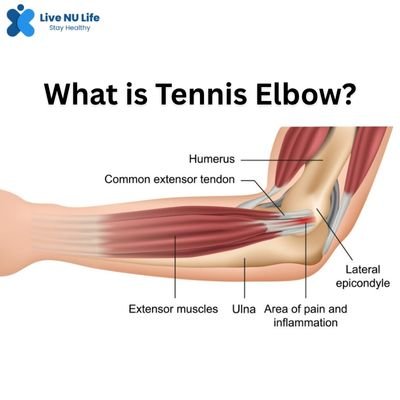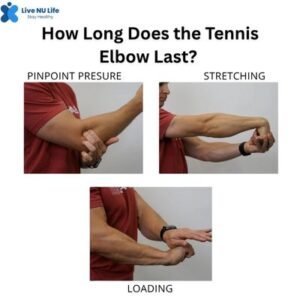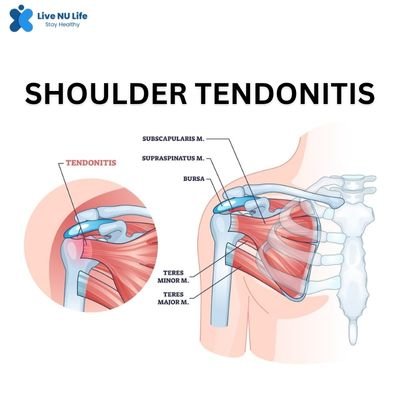Tennis elbow is a widespread phenomenon that is observed by thousands of citizens in different professional areas. As the name of this injury might suggest, it does not exclusively affect athletes. Any person engaging in repeated arm movements, such as raising, typing, or performing manual tasks, may be susceptible to this painful complication. Otherwise, left alone, tennis elbow may disrupt your daily routine and alter the quality of your life.
Here is your in-depth guide as to what tennis elbow is, its causes, its symptoms, and how to cure tennis elbow quickly, as well as the duration of tennis elbow. In the end, there is also a descriptive section called FAQ, to clear the water surrounding some common doubts.
Table of Contents
ToggleWhat is Tennis Elbow?
The medical disease of lateral epicondylitis is also known by the informal name of tennis elbow. It can be summarized as swelling or tiny cracks on the tendons that attach the muscles of your forearms to the skin. It is damaged when overused and repeated, notably using gripping, lifting, or twisting actions.
The problem is mostly with a tendon known as extensor carpi radialis brevis (ECRB) that is involved in the process of flexing the wrist and stabilizing the elbow when in motion.
Overworking of this tendon leads to its irritation, inflammation, and pain.
Tennis Elbow Causes
A tennis elbow is an overuse injury that constitutes itself due to repetitive movements or strain that mainly involves movement of the wrist as well as forearm. This causes a small amount of tears in the tendon fibers attached to the lateral epicondyle (a protrusion in the outer side of the elbow), which then produces the said painful inflammation.
Here are the common causes of tennis elbow:
- Repetitive Arm Motions
Sustained situations of arm use in the same direction, e.g., turning a screwdriver or climbing with a load, can lead to strain in the forearm muscles. In the long term, the tendon over the elbow is likely to be injured. - Improper Technique in Sports or Exercise
In sporting activities such as tennis or badminton, poor technique at the racquet, specifically the backhand strikes, can place pressure on the tendons. It can also be caused by using too heavy or too tightly strung equipment. - Manual Labor Jobs
Occupations that involve repetitive tasks using the arms, such as carpenters, mechanics, plumbers, or painters, have the tendency to contain continual gripping or lifting, thereby exposing them to increased risks of tennis elbow. - Office Work and Computer Use
Strain on the forearm can occur by repetitive mouse clicking, keyboard use, and improper ergonomics, especially the one that is practiced during hours without a break. - Sudden Increase in Physical Activity
It is highly possible that overuse injuries can happen to people who are involved in new activities and who are not prepared otherwise, such as gardening, weight lifting, and home improvement activities.

Summary Table: Common Causes of Tennis Elbow
| Trigger | Description |
|---|---|
| Repetitive Motion | Continuous wrist and arm activity, especially under stress |
| Poor Sports Technique | Especially during racket sports or strength training |
| Heavy Physical Labor | Repeated gripping and twisting during manual work |
| Improper Ergonomics | Bad posture or typing in the office environment |
| Unconditioned Activity | Starting new strenuous tasks without a proper warm-up |
Tennis Elbow Symptoms
It is important to make early diagnoses of the tennis elbow, mainly to provide countermeasures in advance and ensure successful management. The illness normally builds up and, as a consequence, usually begins with mild pain, which progresses to a more severe condition.
The common symptoms of tennis elbow are listed below:
- Stabbing or burning on the external surface of the Elbow
This pain is made worse by the activities of the wrist and hands, including gripping, lifting, or twisting. The pain might be acute or aching, depending on damage severity on the tendon. - Pain That Radiates Down the Forearm
The pain on the elbow is not limited to the outside parts of the elbow; the pain might reach the entire length of the outside of the forearm. - Weak Grip Strength
Holding things, shaking hands, or turning doorknobs becomes hard or painful for a lot of people. - Pain with Specific Movements
Such activities as lifting a kettle, use of any tools, and opening jars can cause or aggravate the pain. - Tenderness to Touch
The elbow area, the exterior of it, may hurt upon touching. - Stiffness in the Elbow or Forearm
This can be more evident during the morning or after spending long durations lying in bed.
How to Heal Tennis Elbow Fast
Tennis elbow healing varies with each patient based on the nature of the condition and the time at which the action is taken. But, proactive actions may do the trick with considerably minimizing the duration of healing.
Here are proven strategies for healing tennis elbow quickly and
effectively:
- Rest and Avoid Overuse
Start or limit pain-producing activities. Further straining of the injured tendon will continue to prolong the healing process. Try to give your arm some time off. - Apply Ice Packs
The cold helps reduce inflammation and pain. Apply it to an icepack or a cold compress and do it 15 out of 20 times and a couple of times a day, particularly immediately after your arm has been used. - Make use of the Tennis Elbow Brace or Strap
By putting on a counterforce brace around your forearm, you reduce loads on the tendon. This should result in less pain on a daily task and the tendon getting adequate healing time, and to strengthen over time. - Take Over-the-Counter Pain Relievers
An anti-inflammatory (steroid) drug, either ibuprofen or naproxen, can relieve the pain, as well as reduce the swelling. They should never take them on a long-term basis without a doctor’s prescription. - Physical Therapy
To help get you more flexible and have stronger tendons, a physical therapist will be able to assist you through stretching and strengthening exercises to achieve these. This will assist in the alleviation of pain and in avoiding repeat injuries. - Gentle Forearm Stretches and Strengthening
The stretching should be light, and then develop the forearm and wrist muscles. The popular activities are towel twists, reverse wrist curls, and wrist curls. - Massage Therapy
Massage enhances blood flow and tissue within the affected part and breaks down scar tissue. A qualified therapist is able to carry out certain procedures that accelerate the recovery of the tendon. - Improve Ergonomics at Work
Use ergonomic equipment and select the workstation that promotes good posture. Like sitting on a chair and desk such that when you type, you set your elbows at a 9090-degrees angle.
How Long Does the Tennis Elbow Last?
Recovery times of tennis elbow all depend on how early it was detected and the extent to which the condition was. Although it is a self-limiting injury (which means that it can be healed without significant medical treatment), the healing process might take from a few weeks to a year.
General Timeline:
| Condition Severity | Estimated Recovery Time |
|---|---|
| Mild | 6–8 weeks |
| Moderate | 3–6 months |
| Severe/Chronic | 6–12 months or longer |
How to Prevent Tennis Elbow
The occurrences of tennis elbow can be as crucial as the prevention of this issue. After going through it, you need to ensure that it does not repeat itself, since your tendons and muscles will need some cushion.
Here’s how you can prevent tennis elbow:
- Warm-Up Before Physical Activity
Prevent muscle injuries from any sport or use of a computer as soon as you stretch your forearms and wrists. - Use Proper Technique
Be in the right form, whether in a sporting activity or at the gym. This minimizes the stress put on the elbow unnecessarily. - Strengthen Forearm and Wrist Muscles
Increase the strength of the surrounding muscles around the elbow so that they are not easily injured. - Take Frequent Breaks
When your job is carried out repetitively, take some stops now and then to relax and stretch your arms. - Use Ergonomic Equipment
Grips on tools, adjustable chairs, and appropriate positioning of the keyboard can reduce the strain. - Avoid Sudden Increases in Activity
Progressively increase the amount of any new physical activity or the amount of time you work at it to give your body time to adapt.
Want to dive deeper into health and fitness? Click here to explore more on how to live a healthier, fitter life.
Conclusion
The condition called tennis elbow can be treated, but it is not always easily treated. Knowing how tennis elbow happens, paying attention to the symptoms, looking into its causes, and knowing the techniques that can help you speed up the process of its healing can mean an unimaginable change in your recovery process. Conservative treatment is not a problem for most people, and adjustment is achieved within a few months. Nevertheless, consistency with prevention measures is the most important aspect to prevent the occurrence of recurrences.
When you have such symptoms, do not hesitate to improve them. Early treatment will save you months of pain and bring you back to your life without pain.
Also interested in learning about autoimmune diseases? Click here to read our blog on how to prevent autoimmune disease.
Know more about tennis elbow. Click here…..
Frequently Asked Questions
Q1. What is the tennis elbow, and what causes tennis elbow?
The tennis elbow is a disease or condition that occurs due to overworking the muscles on the
forearm side, hence, causing pain on the outer efficient of the forearm. It has the propensity to
pass through redundant use of writing and the limbs, or a wrong mechanism of lifting.
Q2. What are the musical symptoms of tennis elbow?
Its symptoms are: pain and a tender feeling on the lateral side of the elbow, pain in the adjacent
segments of the forearm, a meaningless grasp, and tenderness in holding something or lifting.
Q3. So, how do I treat tennis elbow in a minimal time?
Rest the injured arm, use ice packs, immobilize the arm (use a brace), anti-inflammatory drug,
and perform tutored stretching tests. As recommended, consult a physical therapist.
Q4. How long does a tennis elbow take?
It can last between 6 weeks and one year; the more severe it is, the longer it takes. It has been
known that treatment minimizes the recovery process in the short run.
Q5. Is tennis elbow surgery required?
The use of surgery is unpopular and, in most cases, it can only be recommended in situations
where a patient has failed to receive improvements in his or her condition despite having gone
through non-surgical treatment procedures within 6-12 months.








3 Responses